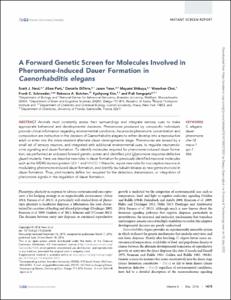Department of Brain Sciences
The K. Kim Lab of Neurobehavior and Neural Circuits
1. Journal Articles
A Forward Genetic Screen for Molecules Involved in Pheromone-Induced Dauer Formation in Caenorhabditis elegans
- Title
- A Forward Genetic Screen for Molecules Involved in Pheromone-Induced Dauer Formation in Caenorhabditis elegans
- Author(s)
- Neal, Scott J. ; Park, JiSoo ; DiTirro, Danielle ; Yoon, Jason ; Shibuya, Mayumi ; Choi, Woochan ; Schroeder, Frank C. ; Butcher, Rebecca A. ; Kim, Kyuhyung ; Sengupta, Piali
- Issued Date
- 2016-05
- Citation
- G3: Genes, Genomes, Genetics, v.6, no.5, pp.1475 - 1487
- Type
- Article
- Keywords
- Article ; ASH NEURONS ; C-ELEGANS ; C. Elegans ; Caenorhabditis Elegans ; Che-12 ; Che-12 Ciliary Gene ; CHemICAL REPELLENTS ; CHemOSENSORY NEURONS ; Controlled Study ; Dauer ; Gene ; Gene Locus ; Gene Mutation ; Genetic Analysis ; Genetic Complementation ; GLR-1 GLUTAMATE-RECEPTOR ; Hormone Determination ; INTRAFLAGELLAR TRANSPORT ; LARVAL DEVELOPMENT ; Maco-1 ; Macoilin Gene ; Nerve Cell ; Nociception ; Nonhuman ; Pheromone ; Pheromone Response Defective Dauer ; Phosphotransferase ; POLYMORPHISM MAP ; Qui-1 ; Regulatory Mechanism ; Signal Transduction ; TAU-TUBULIN KINASE ; TTBK ; Tubulin ; Unclassified Drug ; Up-Regulation
- ISSN
- 2160-1836
- Abstract
- Animals must constantly assess their surroundings and integrate sensory cues to make appropriate behavioral and developmental decisions. Pheromones produced by conspecific individuals provide critical information regarding environmental conditions. Ascaroside pheromone concentration and composition are instructive in the decision of Caenorhabditis elegans to either develop into a reproductive adult or enter into the stress-resistant alternate dauer developmental stage. Pheromones are sensed by a small set of sensory neurons, and integrated with additional environmental cues, to regulate neuroendocrine signaling and dauer formation. To identify molecules required for pheromone-induced dauer formation, we performed an unbiased forward genetic screen and identified phd (pheromone response-defective dauer) mutants. Here, we describe new roles in dauer formation for previously identified neuronal molecules such as the WD40 domain protein QUI-1 and MACO-1 Macoilin, report new roles for nociceptive neurons in modulating pheromone-induced dauer formation, and identify tau tubulin kinases as new genes involved in dauer formation. Thus, phd mutants define loci required for the detection, transmission, or integration of pheromone signals in the regulation of dauer formation. © 2016 Neal et al.
- Publisher
- Genetics Society of America
- Related Researcher
-
-
Kim, Kyuhyung
- Research Interests Neurobehavior; Neural Circuit; Neurodevelopment; 신경회로; 신경행동; 신경발생; 신경유전학
-
- Files in This Item:
-
 기타 데이터 / 1.92 MB / Adobe PDF
download
기타 데이터 / 1.92 MB / Adobe PDF
download
- Appears in Collections:
- Department of Brain Sciences The K. Kim Lab of Neurobehavior and Neural Circuits 1. Journal Articles



